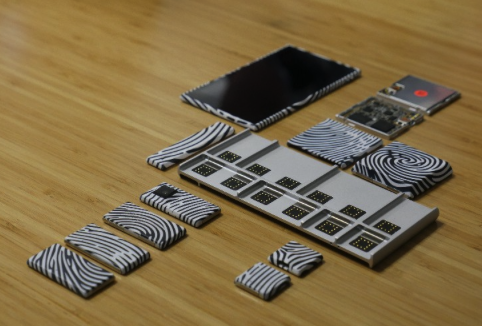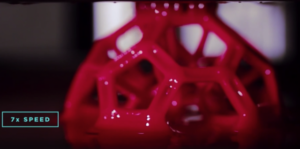Word has come to light of a new continuous liquid interface process (CLIP) for short, that allows 3D ‘printed’ objects to rise out of a kind of primordial (resin) stew – in whole, “grown” through this continuous process – rather than the additive 3D printing of virtual computer images, known now for a decade or so.

Like life itself rising out of its primordial soup this 3D object rises whole and intact from its liquid resin in the continuous light interface process (CLIP) recently announced R&D – Source: Carbon 3DIt stems from research done at the UNC (as of this writing still in the Sweet 16 finals) and a new Silicon Valley start-up called Carbon 3D Inc. Add to this the Google “Black Works” project called “Ara” (publicly known for more than 1 year now) that allows users to build their own smart phone from component pieces, and developed by the same group at Google that produced Google Glass. Project Ara is due to start a market pilot project with working components in (limited numbers) in 2015, according to Google’s FAQ website. But from this confluence of ideas, we may be at the cusp of a new manufacturing/production breakthrough that would set the direction for consumer (even perhaps all) devices for the next decade and possibly beyond.
To be sure the joint UNC/Carbon 3D announcement first revealed at the Vancouver, BC TED talk then published in the March is the most exciting breakthrough since the idea of self replicating machines (Rep-rap) in 3D printing. Carbon 3D, claims the ability to produce from this continuous liquid process, objects below 20 microns (that’s about one-quarter the thickness of a sheet of paper). Development of new liquid composite materials will add to the capabilities and flexibility of the processing idea. The group said it uses light and oxygen to synthesize materials. Projecting a series of cross sectional images using “… beams of light through an oxygen-permeable window into a liquid resin… the light and O2 work in tandem to control the solidification of the resin, creating commercially viable objects,” UNC research group reported. See the YouTube Video Clip at 7x speed, (for effect, try watching while humming the theme to 2001 A Space Odyssey).
 Images of Google’s Black Ops Project Ara that can help extend the life of component devices For the record, Google’s Project Ara offers a modular approach to consumer electronics in general with applications specific to the smartphone, arguably, one of the most prolific electronic devices ever manufactured. It allows everyday folks to build their own device from “phone blocks” or a kind of set of building blocks of hardware components (think Lego). The idea hinges not just on creating another device, but is based on sustainability, addresses the issues of planned obsolescence and works towards reducing harmful electronic waste by making devices modular, easier to repair and perhaps, by changing out aging components rather than the whole phone, will last as long as say your TV (up to 10 years) instead of changing every 1 to 2 years, according to some futurist aspirations.
Images of Google’s Black Ops Project Ara that can help extend the life of component devices For the record, Google’s Project Ara offers a modular approach to consumer electronics in general with applications specific to the smartphone, arguably, one of the most prolific electronic devices ever manufactured. It allows everyday folks to build their own device from “phone blocks” or a kind of set of building blocks of hardware components (think Lego). The idea hinges not just on creating another device, but is based on sustainability, addresses the issues of planned obsolescence and works towards reducing harmful electronic waste by making devices modular, easier to repair and perhaps, by changing out aging components rather than the whole phone, will last as long as say your TV (up to 10 years) instead of changing every 1 to 2 years, according to some futurist aspirations.
To get there, Project Ara created an Endoskeleton (known by the group as the “Endo”) that serves as both a data backbone (nervous system) and provides the structural framework with perhaps multiple antenna also built in (admittedly this is speculation). On its FAQ page, Google said Ara will allow users to tailor their smartphone to meet specific function and aesthetic preferences, with an eye toward delivering the smartphone “…to the next billion people”, an idea that smacks of the popular 1984 Apple Mac slogan “…the computer for the rest of us”, that came on the heels of its “Why 1984 won’t be like 1984” and groundbreaking Superbowl Ad. From projects like this we think Google is working to seize the moral high ground in high-tech.
Bottom line, no we don’t expect to see smartphone components with intricate and technology dense circuitry rise out of a resin bath anytime soon, but there is no denying the Wow effect of seeing the complete virtual object rise from pool of liquid material intact with the level of precision this group reportedly achieved. And when added to the idea of creating next generation devices from a host of modular and swappable components that also contribute to long-term products and sustainability, the future horizon looks brighter still. – Steve Sechrist

